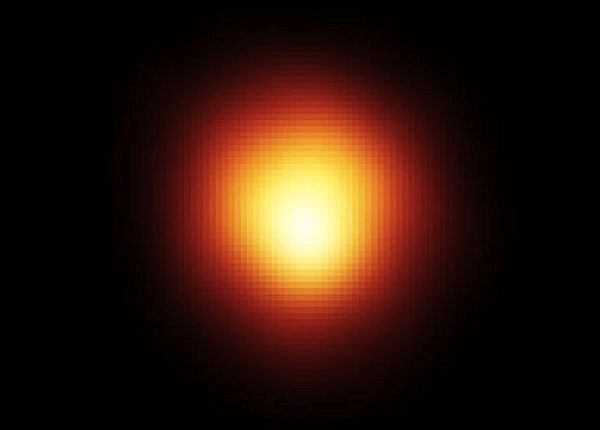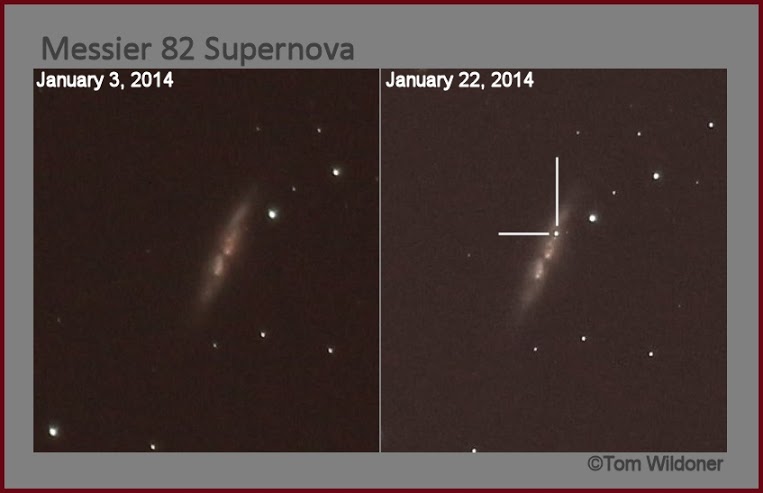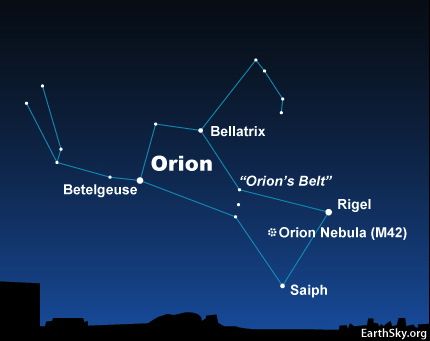
Red Betelgeuse, also known as Alpha Orionis, is the 9th-brightest star in the night sky and 2nd-brightest in the constellation of Orion. Photo by Thomas Wildoner.
On some January or February evening, come to know the red star Betelgeuse in the constellation Orion. It’s not only one of Orion’s brightest stars. It’s also a star that astronomers know will one day explode as a supernova. And by one estimate, it’s only 430 light-years away! Follow the links below to learn more about Betelgeuse and its explosive destiny.
Betelgeuse will explode someday.
Will Betelgeuse become a second sun?
Will the explosion of Betelgeuse destroy earthly life?
What will happen when Betelgeuse goes supernova?
How to see the star Betelgeuse in the night sky.
Betelgeuse in pop culture, history and mythology.

Betelgeuse imaged in ultraviolet light by the Hubble Space Telescope and subsequently enhanced by NASA. The bright white spot is likely one of this star’s poles. Image via NASA/ESA.

View larger. | Thomas Wildoner captured these before-and-after images of the supernova that erupted in January 2014 in the galaxy M82. See the supernova? Astronomers sometimes say that a supernova can outshine the galaxy in which it resides. This photo makes me believe it! Read more about the supernova in M82.
Betelgeuse will explode someday Betelgeuse lies some 430 light-years from Earth. (Note: determining distances, especially to red supergiant stars, is a vexing problem in Astronomy. Estimates vary and are often revised, with some as high as 650 light-years.) Yet it’s already one of the brightest stars in Earth’s sky. The reason is that Betelgeuse is a supergiant star. It is intrinsically very brilliant.
Such brilliance comes at a price, however. Betelgeuse is one of the most famous stars in the sky because it’s due to explode someday. Betelgeuse’s enormous energy requires that the fuel be expended quickly (relatively speaking), and in fact Betelgeuse is now near the end of its lifetime. Someday soon (astronomically speaking), it will run out of fuel, collapse under its own weight, and then rebound in a spectacular supernova explosion. When this happens, Betelgeuse will brighten enormously for a few weeks or months, perhaps as bright as the full moon and visible in broad daylight.
When will it happen? Probably not in our lifetimes. But, in fact, no one really knows. It could be tomorrow or a million years in the future.

Cool image, but we won’t see this from Earth when Betelgeuse goes supernova sometime in the next thousand – or million – years. Image via Geekosystem
Will Betelgeuse become a second sun? Short answer: no. That rumor was flying around in 2012. Remember 2012? The year the world was supposed to end? Anyway, when it does go supernova, Betelgeuse won’t be bright enough to appear as a second sun in our sky.
Instead, anyone alive on Earth when it happens will be treated to an amazingly beautiful sight in the night sky – a very, very, very bright star.
Will the explosion of Betelgeuse destroy earthly life? When Betelgeuse does blow up, our planet Earth is too far away for this explosion to harm, much less destroy, life on Earth. Astrophysicists say we’d have to be within 50 light-years of a supernova for it to harm us. Betelgeuse is nearly 10 times this distance.
So we’re safe from Betelgeuse. And, in fact, if there are any astronomers around when it does blow, they will be extremely thrilled to have a relatively nearby supernova to study.
Artist’s concept showing star Betelgeuse (center), with a series of arcs immediately to the left of the star. The arcs are thought to be material ejected from Betelgeuse as it evolved into a red supergiant. Notice the faint linear bar of dust on the left side of the image. It represents a dusty filament connected to our galaxy’s magnetic field, or the edge of an interstellar cloud. If this filament, or wall, exists – as some astronomers believe – the arcs ejected from Betelgeuse will hit the wall 5,000 years from now. Betelgeuse itself will collide with the wall 12,500 years later. Image via ESA/Herschel/PACS/L. Decin et al. Read more about this image here.
What will happen when Betelgeuse goes supernova? Fortunately for us, it appears that there will be few, if any, adverse affects to Earth when Betelgeuse goes supernova.
If Betelgeuse were side by side with our sun, you’d find it 10,000 times brighter than the sun in visible light. It might be surprising then to learn that the surface temperature of Betelgeuse is only about 6,000 degrees F (3,600 K) in contrast to the sun’s 10,000 degrees F.
In terms of mass, Betelgeuse is thought to be about 15 times the mass of the sun, but 600 times wider and more than 200 million times its volume! When you consider its size, as well as the infrared and other radiations it pumps out, Betelgeuse probably outshines our sun by at least 50,000 times.

Betelgeuse is one of two very bright stars in the constellation Orion the Hunter. The other bright star is Rigel. Notice Betelgeuse and Rigel on either side of the short, straight row of three medium-bright stars. That row of stars represents Orion’s Belt. Betelgeuse is said to represent the right shoulder of the Hunter.
How to see the star Betelgeuse in the night sky. At mid-northern latitudes, around the first of every year, Betelgeuse rises around sunset. The star is very well placed for viewing on January and February evenings.
By the beginning of March, this star is due south in early evening. By mid-May, it can be glimpsed briefly in the west after sunset. Betelgeuse is traveling behind the sun in early summer, but it returns to the east before dawn by about mid-July.
Betelgeuse – in the famous constellation Orion – is easy to spot. See our sky chart to learn the pattern of the constellation Orion the Hunter. Orion itself is noticeable for the short, straight row of three medium-bright stars in its mid-section. Betelgeuse is in the upper left corner of the large rectangle forming Orion.
The star Betelgeuse has a distinctive color: somber orange-red. It’s ideal for convincing non-believers that stars do, in fact, come in colors.
Stars designated as Alpha are typically brightest in their constellations. But Betelgeuse is Alpha Orionis, despite the fact that it’s fainter than Orion’s other bright star, Rigel. Betelgeuse is the 10th brightest star in the sky overall, and it’s the 7th brightest star visible from most of the U.S., Canada, Europe and the majority of the northern hemisphere.

Betelgeuse is often said to represent the right shoulder of the Orion the Hunter. Diagram via stardate.org.
Betelgeuse in pop culture, history and mythology. Remember the movie Beetlejuice? This star’s name is similar.
The proper names of many bright stars are Arabic in origin. This fact reflects the dominance of Arabic astronomers and astrologers during Europe’s Dark Ages. The name Betelgeuse apparently is derived from an Arabic phrase that is usually translated as The Armpit of the Giant. Of course the Giant refers to Orion, but – rather than an armpit – some authors see Betelgeuse as representing a hand or sometimes a shoulder. While it is not entirely clear what the name means, in any event, Betelgeuse marks the right shoulder of Orion in many old star maps.
In the ancient myths, Orion is most often associated with a giant, a warrior, a hunter, a god or some other anthropomorphic or animal figure, so it is not surprising that most depictions of Betelgeuse have an anatomical connection. The Sanskrit name signified an arm, too, for example, although it likely was really the leg of a stag. In parts of Brazil Betelgeuse was seen as the hind leg of a cayman (crocodilian) or the foreleg of a turtle. On the other hand, in ancient Japan, Betelgeuse was considered to be part of the rim of a ceremonial drum. In Peru, it was one of four vultures about to devour a criminal.
Jim Livingston wrote in October, 2016: “I love the golden colors of Betelgeuse against the velvety black night sky.”
The position of Betelgeuse is RA 05h 55m 10.3053s, dec +07° 24′ 25.4″.
Bottom line: The star Betelgeuse is destined to explode someday as a supernova.
EarthSky lunar calendars are cool! They make great gifts. Order now. Going fast!
from EarthSky http://bit.ly/2SSpIqu

Red Betelgeuse, also known as Alpha Orionis, is the 9th-brightest star in the night sky and 2nd-brightest in the constellation of Orion. Photo by Thomas Wildoner.
On some January or February evening, come to know the red star Betelgeuse in the constellation Orion. It’s not only one of Orion’s brightest stars. It’s also a star that astronomers know will one day explode as a supernova. And by one estimate, it’s only 430 light-years away! Follow the links below to learn more about Betelgeuse and its explosive destiny.
Betelgeuse will explode someday.
Will Betelgeuse become a second sun?
Will the explosion of Betelgeuse destroy earthly life?
What will happen when Betelgeuse goes supernova?
How to see the star Betelgeuse in the night sky.
Betelgeuse in pop culture, history and mythology.

Betelgeuse imaged in ultraviolet light by the Hubble Space Telescope and subsequently enhanced by NASA. The bright white spot is likely one of this star’s poles. Image via NASA/ESA.

View larger. | Thomas Wildoner captured these before-and-after images of the supernova that erupted in January 2014 in the galaxy M82. See the supernova? Astronomers sometimes say that a supernova can outshine the galaxy in which it resides. This photo makes me believe it! Read more about the supernova in M82.
Betelgeuse will explode someday Betelgeuse lies some 430 light-years from Earth. (Note: determining distances, especially to red supergiant stars, is a vexing problem in Astronomy. Estimates vary and are often revised, with some as high as 650 light-years.) Yet it’s already one of the brightest stars in Earth’s sky. The reason is that Betelgeuse is a supergiant star. It is intrinsically very brilliant.
Such brilliance comes at a price, however. Betelgeuse is one of the most famous stars in the sky because it’s due to explode someday. Betelgeuse’s enormous energy requires that the fuel be expended quickly (relatively speaking), and in fact Betelgeuse is now near the end of its lifetime. Someday soon (astronomically speaking), it will run out of fuel, collapse under its own weight, and then rebound in a spectacular supernova explosion. When this happens, Betelgeuse will brighten enormously for a few weeks or months, perhaps as bright as the full moon and visible in broad daylight.
When will it happen? Probably not in our lifetimes. But, in fact, no one really knows. It could be tomorrow or a million years in the future.

Cool image, but we won’t see this from Earth when Betelgeuse goes supernova sometime in the next thousand – or million – years. Image via Geekosystem
Will Betelgeuse become a second sun? Short answer: no. That rumor was flying around in 2012. Remember 2012? The year the world was supposed to end? Anyway, when it does go supernova, Betelgeuse won’t be bright enough to appear as a second sun in our sky.
Instead, anyone alive on Earth when it happens will be treated to an amazingly beautiful sight in the night sky – a very, very, very bright star.
Will the explosion of Betelgeuse destroy earthly life? When Betelgeuse does blow up, our planet Earth is too far away for this explosion to harm, much less destroy, life on Earth. Astrophysicists say we’d have to be within 50 light-years of a supernova for it to harm us. Betelgeuse is nearly 10 times this distance.
So we’re safe from Betelgeuse. And, in fact, if there are any astronomers around when it does blow, they will be extremely thrilled to have a relatively nearby supernova to study.
Artist’s concept showing star Betelgeuse (center), with a series of arcs immediately to the left of the star. The arcs are thought to be material ejected from Betelgeuse as it evolved into a red supergiant. Notice the faint linear bar of dust on the left side of the image. It represents a dusty filament connected to our galaxy’s magnetic field, or the edge of an interstellar cloud. If this filament, or wall, exists – as some astronomers believe – the arcs ejected from Betelgeuse will hit the wall 5,000 years from now. Betelgeuse itself will collide with the wall 12,500 years later. Image via ESA/Herschel/PACS/L. Decin et al. Read more about this image here.
What will happen when Betelgeuse goes supernova? Fortunately for us, it appears that there will be few, if any, adverse affects to Earth when Betelgeuse goes supernova.
If Betelgeuse were side by side with our sun, you’d find it 10,000 times brighter than the sun in visible light. It might be surprising then to learn that the surface temperature of Betelgeuse is only about 6,000 degrees F (3,600 K) in contrast to the sun’s 10,000 degrees F.
In terms of mass, Betelgeuse is thought to be about 15 times the mass of the sun, but 600 times wider and more than 200 million times its volume! When you consider its size, as well as the infrared and other radiations it pumps out, Betelgeuse probably outshines our sun by at least 50,000 times.

Betelgeuse is one of two very bright stars in the constellation Orion the Hunter. The other bright star is Rigel. Notice Betelgeuse and Rigel on either side of the short, straight row of three medium-bright stars. That row of stars represents Orion’s Belt. Betelgeuse is said to represent the right shoulder of the Hunter.
How to see the star Betelgeuse in the night sky. At mid-northern latitudes, around the first of every year, Betelgeuse rises around sunset. The star is very well placed for viewing on January and February evenings.
By the beginning of March, this star is due south in early evening. By mid-May, it can be glimpsed briefly in the west after sunset. Betelgeuse is traveling behind the sun in early summer, but it returns to the east before dawn by about mid-July.
Betelgeuse – in the famous constellation Orion – is easy to spot. See our sky chart to learn the pattern of the constellation Orion the Hunter. Orion itself is noticeable for the short, straight row of three medium-bright stars in its mid-section. Betelgeuse is in the upper left corner of the large rectangle forming Orion.
The star Betelgeuse has a distinctive color: somber orange-red. It’s ideal for convincing non-believers that stars do, in fact, come in colors.
Stars designated as Alpha are typically brightest in their constellations. But Betelgeuse is Alpha Orionis, despite the fact that it’s fainter than Orion’s other bright star, Rigel. Betelgeuse is the 10th brightest star in the sky overall, and it’s the 7th brightest star visible from most of the U.S., Canada, Europe and the majority of the northern hemisphere.

Betelgeuse is often said to represent the right shoulder of the Orion the Hunter. Diagram via stardate.org.
Betelgeuse in pop culture, history and mythology. Remember the movie Beetlejuice? This star’s name is similar.
The proper names of many bright stars are Arabic in origin. This fact reflects the dominance of Arabic astronomers and astrologers during Europe’s Dark Ages. The name Betelgeuse apparently is derived from an Arabic phrase that is usually translated as The Armpit of the Giant. Of course the Giant refers to Orion, but – rather than an armpit – some authors see Betelgeuse as representing a hand or sometimes a shoulder. While it is not entirely clear what the name means, in any event, Betelgeuse marks the right shoulder of Orion in many old star maps.
In the ancient myths, Orion is most often associated with a giant, a warrior, a hunter, a god or some other anthropomorphic or animal figure, so it is not surprising that most depictions of Betelgeuse have an anatomical connection. The Sanskrit name signified an arm, too, for example, although it likely was really the leg of a stag. In parts of Brazil Betelgeuse was seen as the hind leg of a cayman (crocodilian) or the foreleg of a turtle. On the other hand, in ancient Japan, Betelgeuse was considered to be part of the rim of a ceremonial drum. In Peru, it was one of four vultures about to devour a criminal.
Jim Livingston wrote in October, 2016: “I love the golden colors of Betelgeuse against the velvety black night sky.”
The position of Betelgeuse is RA 05h 55m 10.3053s, dec +07° 24′ 25.4″.
Bottom line: The star Betelgeuse is destined to explode someday as a supernova.
EarthSky lunar calendars are cool! They make great gifts. Order now. Going fast!
from EarthSky http://bit.ly/2SSpIqu

Aucun commentaire:
Enregistrer un commentaire